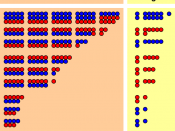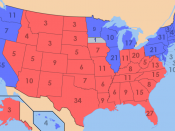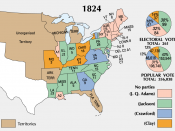Over the years, many conflicts have arisen about the process in which our president is elected. The election of 2000 opened up the public's eyes to the election process and how the Electoral College works. This also brought out the flaws that the Electoral College possesses. This has led to many debates about improving or totally changing the presidential election process.
The Electoral College distributes votes according to the number of representatives in the Senate for each state and The House of Representatives. This means that the number of electors that each state receives can change each decade according to the census and how many representatives each state receives for the house.(Unknown, How The Electoral College Works) The popular vote is then taken for each state, and whatever party or representative receives the most popular votes, receives all the electoral votes for that state. With the Electoral College, the party that receives the most votes within the state takes all the electoral votes.
This is a winner takes all system. One party could receive one more popular vote than another party and they still receive all the electoral votes. There are a total of 538 electoral votes. A representative only needs 270 votes to win the presidency (Hancock. "Distribution of Electoral Votes"). Is this winner take all process fair for the election process and representation in each state? This means that a candidate can put a majority of their effort into the largest 10 states or so and if they win these states they can also win the election without having the popular vote. This occurred in the 2000 election between George W. Bush and Al Gore. Al Gore won the popular vote by about half a million votes. George Bush won the election because he received the most...



Electoral College
Should be abolished.
1 out of 1 people found this comment useful.